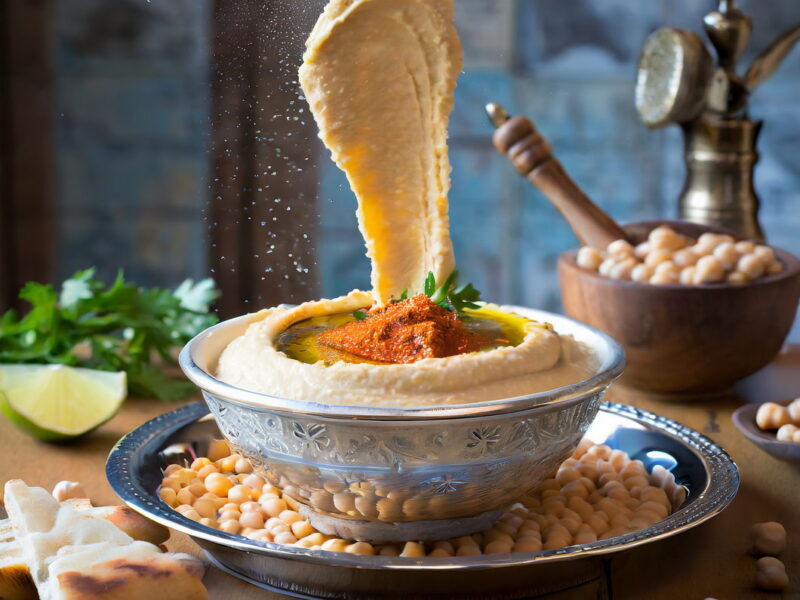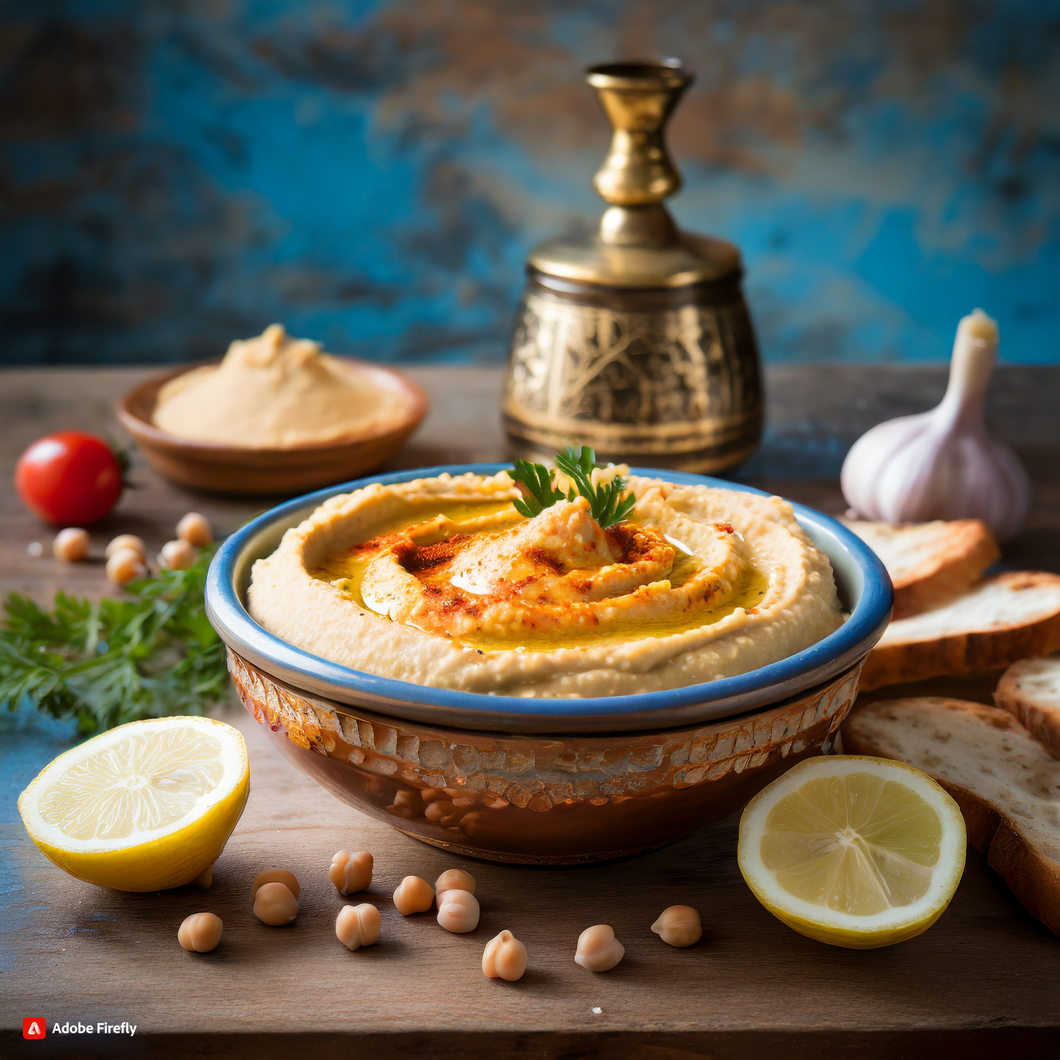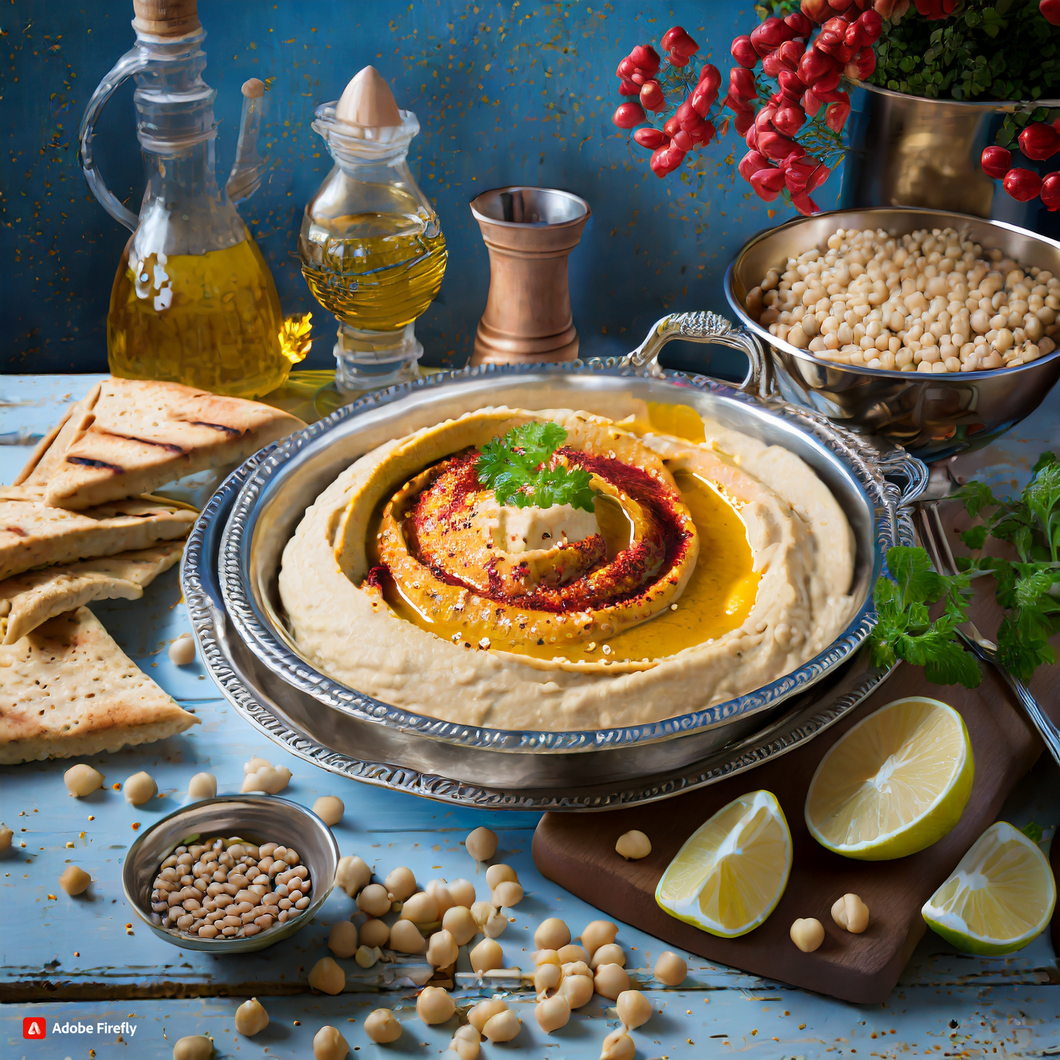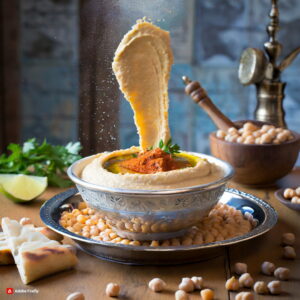Cooking time
- Preparation time
- 15 mins
- Cooking time
- 15 mins
- Difficulty
- easy
- Serves
- 2 people
- Meal course
- Dinner
- Posted by
- Posted on
- December 14, 2023
Ingredients
- 1 cup
- Chickpea
- 3 tablespoon
- Tahini
- 1 cloves
- Garlic
- 2 tablespoon
- Lemon juice
- 2 tablespoon
- Olive oil
- 1/2 Ts
- Ground cumin
- 1/2 As Needed
- Salt
- 4 tablespoon
- water
- 1/2 for garnish
- fresh parsley
- 1/2 for garnish
- paprika

Introduction
Welcome to the world of homemade delight! In this guide, we’ll unravel the secrets to crafting the perfect hummus – a simple yet irresistible blend of flavors that will elevate your snacking experience. From chickpeas to tahini, join us on a journey to create a batch of creamy goodness that’s bound to become your go-to dip. Let’s dive into the heart of hummus-making and unleash a burst of flavor in every bite!
10 benefits of this hummus recipe

Protein Powerhouse
Chickpeas, the main ingredient, are rich in protein, making hummus a satisfying and nutritious snack.
Heart-Healthy Olive Oil
The addition of extra-virgin olive oil provides healthy monounsaturated fats, promoting heart health.
Vitamin C Boost
Fresh lemon juice not only adds zing but also contributes vitamin C, boosting your immune system.
Mineral-Rich Tahini
Tahini, made from sesame seeds, adds a dose of essential minerals like calcium and iron.
Flavorful Garlic Goodness
Minced garlic not only enhances the taste but also brings immune-boosting and anti-inflammatory properties.
Digestive-Friendly Cumin
Cumin not only adds a warm, earthy flavor but also aids digestion and provides a source of iron.
Low-Glycemic Goodness
Hummus has a low glycemic index, providing sustained energy without spiking blood sugar levels.
Versatile Snacking
Use it as a dip, spread, or topping, adding variety to your meals and snacks.
Hydration Boost
Adjust the consistency with water, ensuring a well-hydrated and smooth texture without excess calories.
Customizable Delight
This recipe serves as a canvas for creativity—add herbs, spices, or roasted veggies to tailor it to your taste preferences.
From nutritional power to culinary versatility, this recipe offers a range of benefits that go beyond just great taste!
Nutritional Content per Serving
- Calories: Around 70-80 kcal
- Protein: Approximately 2-3 grams
- Fat: Around 5-6 grams (mostly healthy fats from olive oil and tahini)
- Carbohydrates: About 6-8 grams
- Fiber: Around 2 grams
- Sugar: Less than 1 gram
- Sodium: Varies based on added salt; typically, homemade hummus has less sodium compared to store-bought versions
- Hummus is a nutritious snack, rich in plant-based protein, healthy fats, and fiber. The main source of protein comes from the chickpeas, while the tahini provides healthy fats and additional protein. The olive oil contributes monounsaturated fats and enhances the creamy texture.
Calories (Around 70-80 kcal)
This represents the energy content of the hummus. Calories provide the energy necessary for bodily functions and activities.
Protein (Approximately 2-3 grams)
Protein is essential for building and repairing tissues in the body. Chickpeas, the main ingredient in hummus, are a good plant-based source of protein.
Fat (Around 5-6 grams – mostly healthy fats)
Fats are necessary for nutrient absorption and play a role in various bodily functions. The fats in hummus mainly come from olive oil and tahini, providing monounsaturated fats which are considered heart-healthy.
Carbohydrates (About 6-8 grams)
Carbohydrates are the body’s primary source of energy. The carbohydrates in its primarily come from chickpeas.
Fiber (Around 2 grams)
Fiber is crucial for digestive health and can help with maintaining a feeling of fullness. Chickpeas contribute dietary fiber to hummus.
Sugar (Less than 1 gram)
Hummus typically contains minimal added sugars. The small amount of sugar may come from natural sugars present in the ingredients, but it’s generally low.
Sodium (Varies based on added salt)
Sodium is a mineral that plays a role in fluid balance and nerve function. The amount of sodium can vary based on whether you add salt to your recipe. Homemade hummus often has less sodium compared to store-bought versions.
It’s important to note that these values are approximations and can vary based on the specific ingredients and quantities used in your hummus recipe. Additionally, these values are for a standard serving size of about 2 tablespoons. If you have specific dietary considerations or health concerns, it’s advisable to tailor recipes to meet your individual needs or consult with a nutrition professional.
The history of hummus

The history of hummus is quite ancient and spans several centuries. Hummus is a traditional Middle Eastern dish with roots that can be traced back to various cultures in the region.
Ancient Origins
The origins of hummus are believed to date back to ancient Egypt, where a similar dish called “ta’amia” was made from ground chickpeas, sesame seeds, and various spices. Chickpeas were a staple in the diet of many ancient civilizations due to their nutritional value.
Middle Eastern Roots
The modern version of hummus, as we know it today, is closely associated with the Levant region, which includes countries like Syria, Lebanon, Jordan, and Palestine. In this region, hummus has been a dietary staple for centuries.
Regional Variations
Different countries and communities in the Middle East have their variations of hummus, with slight differences in ingredients and preparation methods. For example, some regions may add additional ingredients like cumin, paprika, or yogurt for extra flavor.
Spread to the Western World
Hummus gained popularity in the Western world in the latter half of the 20th century, particularly in the United States and Europe. Its rise in popularity is often attributed to the growing interest in Mediterranean and Middle Eastern cuisines.
Global Popularity
Over the last few decades, hummus has become a global phenomenon. Its reputation as a nutritious and flavorful dip or spread has led to its widespread availability in supermarkets and restaurants worldwide.
Cultural Significance
Hummus is not just a dish; it holds cultural significance and is often associated with communal eating. It is commonly served as part of mezze, a selection of small dishes served in the Middle Eastern and Mediterranean cuisines.
Controversy
The ownership of hummus has sparked some friendly controversies among countries in the Middle East, each claiming it as their own. For example, both Israel and Lebanon have claimed hummus as a national dish, leading to a “hummus war” of sorts.
In summary, hummus has a rich and diverse history that spans centuries and has become a beloved and internationally recognized dish. Its journey from the ancient world to contemporary global cuisine is a testament to its enduring appeal.
some key tips for preparing a delicious hummus

Use Quality Ingredients
Choose high-quality chickpeas, tahini, and olive oil. The freshness and quality of these ingredients significantly impact the flavor and texture of the hummus.
Soften Chickpeas:
If you’re using canned chickpeas, it’s a good idea to soften them further. You can do this by simmering them in boiling water for a few minutes or by adding a pinch of baking soda to the cooking water.
Remove Chickpea Skins (Optional)
For an extra smooth texture, consider removing the skins from the chickpeas after boiling. While optional, this step can enhance the creaminess of the hummus.
Fresh Lemon Juice
Use freshly squeezed lemon juice for the best flavor. The acidity of the lemon juice brightens the hummus and complements the other ingredients.
Well-Stirred Tahini
Tahini tends to settle, so make sure to stir it well before measuring. This ensures an even distribution of its rich, nutty flavor throughout the hummus.
Balancing Flavors
Taste as you go and adjust the ingredients to achieve the desired balance. Add more lemon juice for acidity, tahini for richness, or salt for seasoning.
Garlic Preparation
If you enjoy a stronger garlic flavor, you can roast the garlic before adding it to its. Alternatively, you can use roasted garlic cloves for a milder taste.
Blend Thoroughly
Blend the ingredients thoroughly in a food processor to achieve a smooth and creamy consistency. You might need to scrape down the sides of the processor to ensure all ingredients are well incorporated.
Adjust Consistency with Water
If it is too thick, add water gradually until you reach your desired consistency. This step ensures a creamy texture without compromising flavor.
Garnish Creatively
When serving, drizzle with extra-virgin olive oil and sprinkle a dash of ground paprika. Fresh chopped parsley can also be a colorful and flavorful garnish.
Serve at Room Temperature
It often tastes best when served at room temperature. If refrigerated, let it sit out for a bit before serving to allow the flavors to develop.
Experiment with Variations
Don’t be afraid to experiment with additional ingredients like roasted red peppers, cumin, or different herbs to create unique variations of hummus.
By paying attention to these tips, you can enhance the overall quality and flavor of your homemade it. Enjoy!
Note: If you want to use more than 2 main ingredients of chickpeas and tahini , you can also use the following ingredients to complete this dish. Otherwise, instead of adding ingredients, use the two main ingredients.
- 1 clove garlic, minced
- 2 tablespoons fresh lemon juice
- 2 tablespoons extra-virgin olive oil, plus more for serving
- 1/2 teaspoon ground cumin
- Salt, to taste
- 3 to 4 tablespoons water (adjust for desired consistency)
- Optional garnish: Paprika, fresh parsley
Please follow us on linkedin. You can learn all best canadian food recipes you can check our Culinary 1TouchFood Youtube and Telegram 1TouchFood page. Don’t forget Fighting Obesity Magazine and Radio Cooking.
Hummus Heaven: Unleash Flavor in 60 Seconds - 1Touch Food Culinary Center

Welcome to the world of homemade delight! In this guide, we'll unravel the secrets to crafting the perfect hummus - a simple yet irresistible blend of flavors that will elevate your snacking experience. From chickpeas to tahini, join us on a journey to create a batch of creamy goodness that's bound to become your go-to dip. Let's dive into the heart of hummus-making and unleash a burst of flavor in every bite!
Type: snack
Cuisine: Middle East
Keywords: Hummus
Recipe Yield: 2
Calories: 80
Preparation Time: PT0H15M
Cooking Time: PT0H15M
Total Time: PT0H30M
Recipe Ingredients:
- 1 cup Chickpea
- 3 tablespoon Tahini
- 1 cloves Garlic
- 2 tablespoon Lemon juice
- 2 tablespoon Olive oil
- 1/2 Tea Spoon Ground cumin
- 4 tablespoon water
Recipe Instructions: Prepare Chickpeas: If using canned chickpeas, drain and rinse them. If using dried chickpeas, cook them until soft (boil or use a pressure cooker). Blend Ingredients: In a food processor, combine the chickpeas, tahini, minced garlic, lemon juice, olive oil, cumin, and a pinch of salt. Blend Until Smooth: Process the ingredients until the mixture is smooth. Stop and scrape down the sides of the food processor if needed. Adjust Consistency: With the food processor running, gradually add 3 to 4 tablespoons of water until you reach your desired creamy consistency. Season to Taste: Taste the hummus and adjust the seasoning. Add more salt or lemon juice as needed to suit your preferences. Serve: Transfer the hummus to a serving dish. Drizzle with extra-virgin olive oil and sprinkle with a dash of paprika for color if desired. Garnish (Optional): Garnish with fresh chopped parsley for a burst of freshness. Enjoy: Serve the hummus with pita bread, vegetable sticks, or as a spread on sandwiches. This quantity is suitable for two people. This quick and easy hummus recipe with chickpeas and tahini is perfect for a small serving and can be customized with additional spices or herbs according to your taste.
5
Instructions
- Prepare Chickpeas: If using canned chickpeas, drain and rinse them. If using dried chickpeas, cook them until soft (boil or use a pressure cooker).
- Blend Ingredients: In a food processor, combine the chickpeas, tahini, minced garlic, lemon juice, olive oil, cumin, and a pinch of salt.
- Blend Until Smooth: Process the ingredients until the mixture is smooth. Stop and scrape down the sides of the food processor if needed.
- Adjust Consistency: With the food processor running, gradually add 3 to 4 tablespoons of water until you reach your desired creamy consistency.
- Season to Taste: Taste the hummus and adjust the seasoning. Add more salt or lemon juice as needed to suit your preferences.
- Serve: Transfer the hummus to a serving dish. Drizzle with extra-virgin olive oil and sprinkle with a dash of paprika for color if desired.
- Garnish (Optional): Garnish with fresh chopped parsley for a burst of freshness.
- Enjoy: Serve the hummus with pita bread, vegetable sticks, or as a spread on sandwiches. This quantity is suitable for two people. This quick and easy hummus recipe with chickpeas and tahini is perfect for a small serving and can be customized with additional spices or herbs according to your taste.

No comments yet, be the first to leave one!